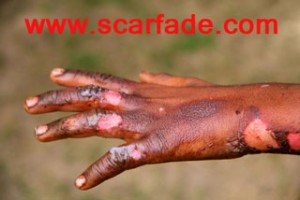
Superficial Burns
Also known as first-degree burns, the outer layer of the skin, called the epidermis, is damaged. The skin is painful, dry and red. It may eventually peel, but doesn’t always scar. Examples of superficial burns are sunburn and some scalds.
Second-Degree Burns
When the second layer of skin, called the dermis, is affected, the result is usually blistering, redness and swelling. Discoloration of the skin may result, which can be treated with scar cream once the injury has healed. Sun exposure to the area within the first year can result in continued pigment changes and should be avoided. Sunscreen of SPF 15 or greater is recommended. When using Scarfade over second-degree burns on the face, make-up can be worn to further minimize the scars.
Full-Thickness Burns
Third-degree burns can result from a variety of causes, from fire to radiation exposure to hot liquids. They destroy the dermis and epidermis, sometimes damaging nerve endings and hair follicles. The skin may have a red or black appearance. Some burn injuries are treated through surgical procedures, like skin grafts and transplants. Reconstruction surgery can improve the new, scarred skin’s flexibility and alter the shape and size of the scar. Once severe burn injuries and any surgical incisions have healed, they may be revised more than once to improve the appearance. The use of silicone scar gel can assist in minimizing the visual effects.
Keloids
Keloid scars are raised red scars that take on shape higher than the skin’s normal surface and may grow beyond the boundaries of the original burn site. They are common in the aftermath of burns and are difficult to control, even with surgery. Use of Scarfade silicone scar gel can help to limit the growth of keloids and reduce the discoloration.
Hyper-Pigmentation and Hypo-Pigmentation
Hyper-pigmentation can take on an unusual shape and uneven coloring. It is caused by excess melanin produced during the healing process by melanocytes, which are found at the bottom of the epidermal layer. Depending on the person’s natural skin tone and the severity of the burn, the scar can achieve drastic contrast in color to the surrounding skin, such as dark brown, purple, red or pink. Hypo-pigmentation is the formation of white scars containing no melanin. Once the wound has healed and there is no infection, Scarfade silicone sheeting and silicone scar gel can be used to reduce hyper-pigmentation and hypo-pigmentation.
